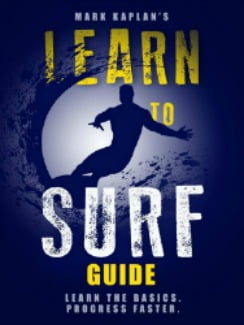Beginner Surfers Catch Real Waves
Beginner surfers catch real waves after they have practiced catching foam waves. The beginner surfer should start with an 8’or 9′ soft top board in shallower water on beach breaks.
Once the surfer is able to catch waves and ride to the beach without falling off the surfboard, they should start paddling out to catch bigger foam waves and look for small real waves.
Timing Real Waves
A real wave peaks and the surfer wants the wave to come under their board before the wave breaks. The surfer knows about where the real waves are forming and paddles in the area to develop momentum and sort of patrols waiting for the wave.
When the surfer sees the wave start to form, they have to judge where it is going to peak. They might paddle out, parallel, or in to get in the right spot. The surfer can catch the wave to ride straight or angle to the right or left to head immediately into the pocket.
Paddling and Pop Up
The surfer paddles to the right position and as the wave comes under the board and lifts the tail, the surfer paddles hard for three to five paddles until he feels the push. Once he feels the push, he puts his hands on the board like a man’s push up and goes through the count to pop.
If a surfer wants to go directly to the pocket, he paddles hard to catch the wave and can then point toward the pocket before the pop up. Once he pops the board is already driving the pocket. If the surfer goes straight down the face, then he has to bottom turn into the pocket.
Watching Other Surfers
Etiquette in the line up dictates that the first surfer to catch the wave near the apex (where the foam comes over the lip) has the right away. If you want to keep your session friendly, observe this rule.
When the waves start to form, surfers will start paddling to indicate they want the wave. If you wait your turn, others will probably give you a shot at a wave. If there are too many surfers acting aggressively and wanting every wave, you might try to move down the line to another section (break).
Often the waves if you are on a sand bar beach and not a reef will form once on the outside and reform closer to shore. Beginner/intermediates might start on the break closer to shore because it will be less crowded and smaller.
Learn More
For Oceanside Surf Lessons, see the Home Page
See the Post Surf Lessons Begin with Foam Waves
See the Post What You Learn in a 2 Hour Lesson
See the Post How to Progress in Surfing
See My Dry Land and In Water Demo video
See How to Catch a Green/Real Wave video
i have lowered my book and course prices for the lock down.
My New Surfing Course in an E-Book plus Demo Video
Get the 18 Chapter, 7,500 word Course that can prepare you for a lesson or give you the fundamentals if you are going to try it on your own. 10 years of teaching 350 students a year has given me the insights on the most precise measures you must follow for success. This course is what I teach on the dry land and in water instruction. The Course includes a 15 minute video on my dry land and in water demonstration. Only $4.95
Buy the E-book for $2.99. Learn to Surf (Different cover but same book)
Buy the Paperback on Amazon $6.95
Get Learn to Surf Course in 29 minute audio. Great prep for a lesson, reviewing after a lesson, learning on your own, refreshing after not having surfed for a while. See Table of Contents. Only $7.95

80 page Learn to Surf Book
![Surf Instructions Beginner to Advanced: Learn to Ride Waves by [Kaplan, Mark]](https://images-na.ssl-images-amazon.com/images/I/51HswFtoBQL.jpg)
Buy my E-book on Amazon Kindle for $2.99. 80 pages of beginner to advanced instructions to help you before the first lesson to learning expert techniques and tricks.
I also have books on Creating Your Own Happiness on a site called Happiness and Work Life Balance